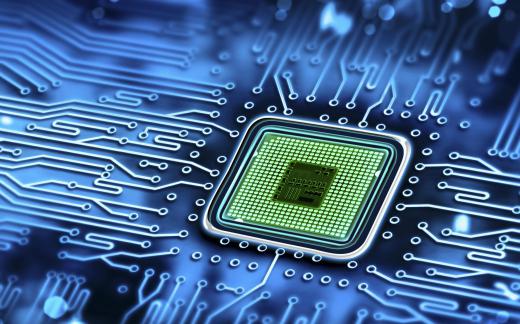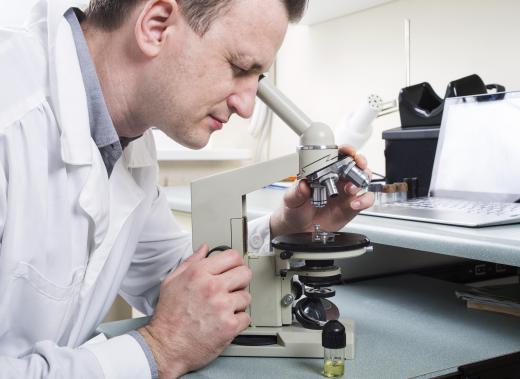What is Microfabrication?
Microfabrication and micromachining are terms that describe the technologies and processes used in making microscopic structures or devices. These structures can range in size from the width of a human hair down to smaller than a single human cell. The ability to build devices this small has spurred technological advancements in computers, consumer electronics, green energy technology and many other fields. Microfabrication techniques vary widely depending on the device being built.
In the field of microfabrication, sizes are measured in micrometers. A micrometer, frequently known as a micron, is one-thousandth of a millimeter. There are 25,400 microns in one inch. Nanotechnology is a similar field, but it deals with even smaller components.

The use of microfabricated parts was pioneered by the semiconductor industry. The inventions of the transistor and integrated circuit in the 1940s and 1950s gave rise to a miniaturization trend in electronics. As microfabrication techniques improved, smaller and more complex integrated circuits were built, allowing powerful microchips to be built.
An increasing number of industries rely on microfabrication. Tiny machines known as micro-electro-mechanical systems can be found in many devices, including smart phones and car airbag sensors. Fuel cells and solar panels also use microfabricated parts. Microfabrication techniques and technologies have been used in research applications in fields from microbiology to particle physics.

The techniques used in a microfabrication process depend on the industry and desired result. Most techniques are top-down approaches, meaning that they start with a larger component, such as a silicon wafer, and remove from it until the final structure is created. Examples of top-down techniques used at the microscopic level include cutting, polishing and etching.
Bottom-up manufacturing in this field is a largely experimental field. In the bottom-up approach, smaller items such as atoms or molecules are used to create a larger system or device. Bottom-up techniques are used in applications intended to mimic biological structures or functions.
Many of the techniques used in microfabrication are borrowed from other disciplines. The fields of photography, optics and physics have contributed to microtechnology. Some traditional manufacturing techniques, such as injection molding, have been miniaturized and used in microfabrication.
Regardless of the technique used, fabrication on a microscopic level presents unique challenges. The small size means that a single piece of dust can render a device useless. Microfabrication labs are rooms designed to control airborne particles such as dust and microbes. Workers must wear protective clothing within these rooms in order to prevent contamination of the microscopic parts being created.
AS FEATURED ON:
AS FEATURED ON:












Discussion Comments
@miriam98 - I’ll bet you anything that they use lasers in a microfabrication laboratory. Lasers are precise, targeted beams of light and I believe they are used in a lot of manufacturing processes. They are certainly suitable for building components at the microscopic level in my opinion.
@NathanG - I’m not an expert but I believe that through etching microfabrication is made possible.
I used to mess around with electronics as a hobby, and one of the things I did was build circuits using printed circuit boards. I “drew” my circuit on the board using a special pen and then dissolved the board in an etching fluid.
Everything was etched away except the circuit design drawn by my pen. That is microfabrication in its essence – at least one example of it – and it doesn’t require a lot of high technology in my opinion.
I’m sure they had some of those etching or molding techniques back then.
@hamje32 - I have no idea how they do that either. I am even more curious as to what kind of technology existed in the 1940s and 1950s which gave rise to the transistor and the integrated circuit. I don’t think these were the same miniaturized transistors they have today, the kind used in many computers.
Still, the transistors were tiny components. I’d be curious to know what kind of tools existed that enabled the construction of transistors back in those days. That was the era, after all, of the vacuum tube; it was still used in many industrial supercomputers.
I’m sure some technological breakthrough allowed silicon microfabrication to take place so that ultimately transistors replaced the vacuum tubes.
The bottom up approach to microfabrication is very precise. You’re manipulating atoms and molecules. I can’t even envision how they would accomplish this. Probably they use biochemical approaches to fabricate the product. I think nanotechnology would certainly be useful in this regard too.
Are we really at the point nowadays where we can build stuff, a molecule at a time? I know that matter can neither be created nor destroyed, so they are probably reassembling existing molecules to create new stuff.
Still, I can’t wrap my head around how this process is possible. Anyway, I guess that’s why this approach to manufacturing is still considered experimental, as the article points out.
Post your comments